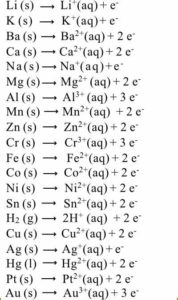Exercise Answers/Solutions
Exercise 1. Consider the partial activity series below to answer the questions.
Mn(s) → Mn2+ (aq) + 2 e–
Fe(s) → Fe2+ (aq) + 2 e–
Ag(s) → Ag+ (aq) + e–
Hg(l) → Hg2+ (aq) + 2 e–
a) Which metal is the weakest reducing agent? Hg(l)
b) Will solid iron reduce manganese ion? No. Manganese ion is above Fe.
c) Will the following reaction occur? Fe(s) + Hg 2+ (aq) → Fe2+ (aq) + Hg (l)
Yes, Fe (s) will reduce Hg2+.
Exercise 2. Use the partial activity series below to write a reaction with manganese and silver.
Mn(s) → Mn2+ (aq) + 2 e–
Fe(s) → Fe2+ (aq) + 2 e–
Ag(s) → Ag+ (aq) + e–
Hg(l) → Hg2+ (aq) + 2 e–
Exercise 3. Use the following activity series to write a balanced equation for the reactions below. If no reaction occurs, just write NR.
a) Fe (s) + Cu(NO3)2(aq) → Cu (s) + FeO(NO3)2(aq)
b) Sn (s) + 2 HBr (aq) → SnBr2 (aq) + H2
c) Al (s) + CoSO4 (aq) →Al2(SO4)3 (aq)
d) Zn (s) + MgSO4 (aq) → No Reaction
Exercise 4. Use the following reactions to arrange an activity series for the elements A, B, C, and D.
B + D+ → B+ + D
C+ + D → no reaction
B + C+ → B+ + C
The elements A, B, C, and D would rank as A, B, C, D–with A being the strongest reducing agent.
Back to the Activity Series

